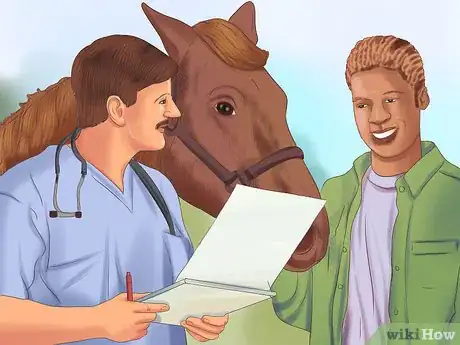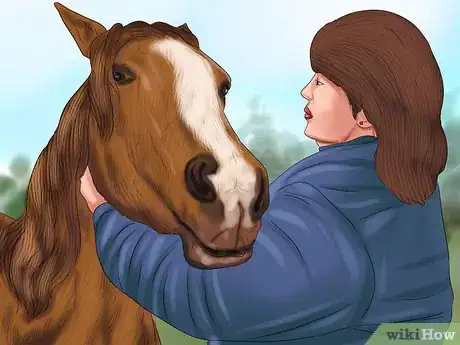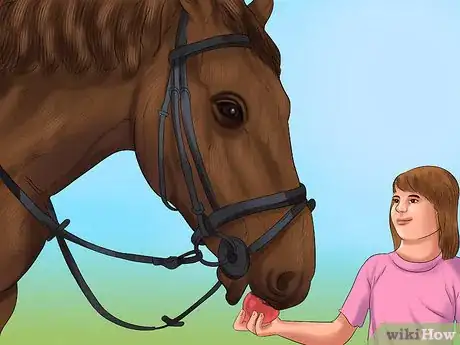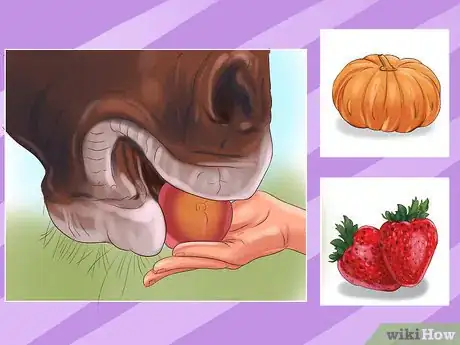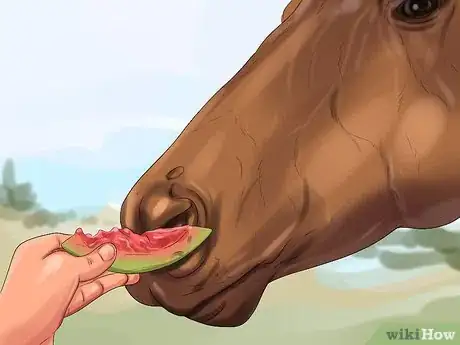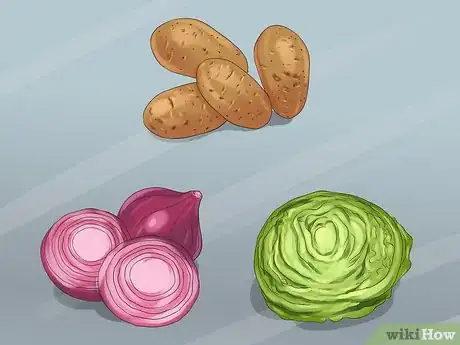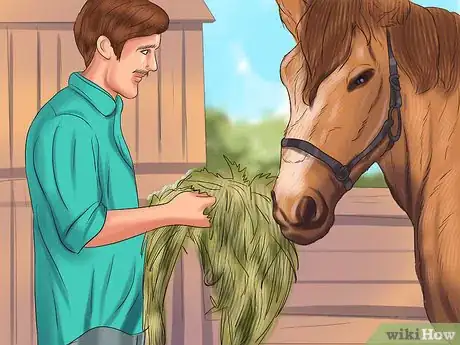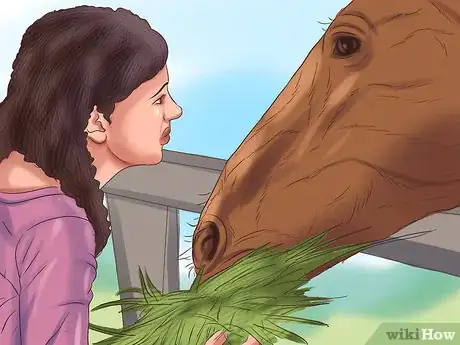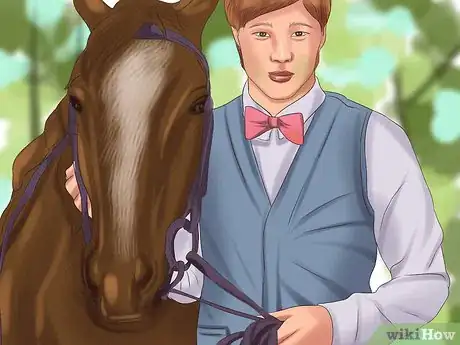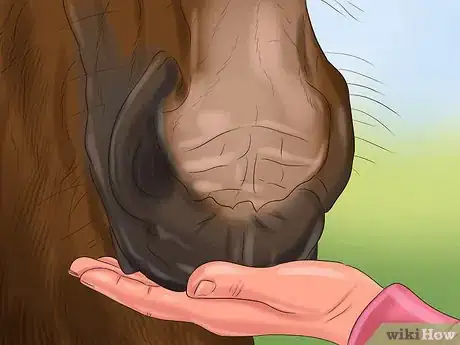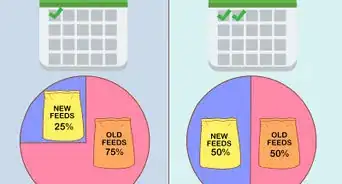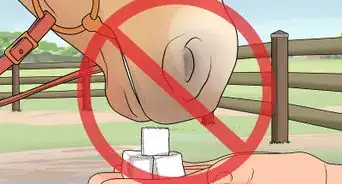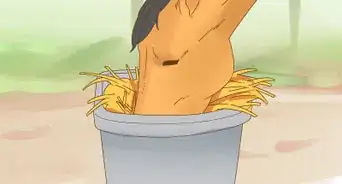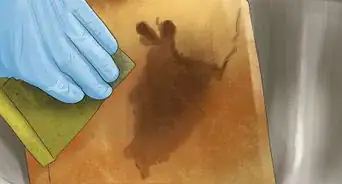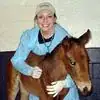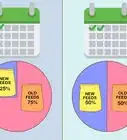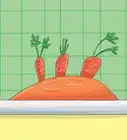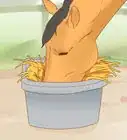This article was co-authored by Ryan Corrigan, LVT, VTS-EVN. Ryan Corrigan is a Licensed Veterinary Technician in California. She received her Bachelor of Science in Veterinary Technology from Purdue University in 2010. She is also a Member of the Academy of Equine Veterinary Nursing Technicians since 2011.
There are 7 references cited in this article, which can be found at the bottom of the page.
This article has been viewed 44,394 times.
Whether you own your own horse or just enjoy visiting them in pastures or stables near your home, it can be a rewarding experience to hand feed a horse. If you follow safety procedures and offer the horse the proper food or treat when hand-feeding, you and the horse can enjoy a bonding experience.
Steps
Feeding a Horse By Hand Safely
-
1Get permission to approach and feed horses that are not yours. If you see some horses grazing in a pasture on the side of the road, don't assume you can simply approach the fence and offer them food. You must always as the owner's permission before approaching or feeding any horses that do not belong to you.[1]
- Some horses might be on a very specific diet, and offering them food outside of that diet could be harmful. Alternatively, some horses may have biting tendencies or aggressive behaviors, and you don't want to approach any horse without being aware of these tendencies beforehand.
-
2Approach the horse with caution. Never run at a horse. Do not come at the horse from behind, as you might spook it. Approach the horse from the front, and off to the side a bit. Approaching at a slight angle toward the shoulder will allow it to see you a bit better.[2]
- Don't approach a horse directly from the front since that's where its blind spot is. Make sure you are coming to it from the side a bit as that is where its best vision is. Walk slowly and don't lunge towards the horse or make any sudden movements.
Advertisement -
3Let the horse know you are coming. Talking softly, clicking your tongue, or speaking the horse's name will let it know you are approaching. You might see its ears twitch as it hears your voice, and it may turn to look at you when it hears you. This will let you know the horse has acknowledged your presence and you haven't startled it.[3]
- Don't make any strange or overly loud noises to let the horse know you're there. Just speak quietly or make noises it is used to hearing.
-
4Hold your hand out flat. When offering a horse food with your hand, you want to make sure your hand is flat with your fingers together and the food or treat on your palm. Doing this will keep your fingertips away from the horse's mouth, and it will be less likely to accidentally nip you while taking the food.[4]
- Avoid holding your hand too high. Let the horse drop its head down to take the treat from your palm. That way, the horse will be reaching down into your palm rather than coming straight onto your fingertips.
Feeding the Proper Treats
-
1Offer the horse fruits, vegetables, or manufactured horse treats. Horses particularly love apples and carrots, but you can also offer a myriad of other things, including melons, snow peas, pumpkin, and strawberries. You can also choose to offer treats made specifically for horses that can be purchased at horse supply stores.[5]
- For a sweet treat, you can even offer the horse a few peppermint candies or sugar cubes. Make sure you only give these occasionally, and only a few at a time.
-
2Break off small pieces to feed to the horse. Some horses might chew and swallow the treats you give them, while others might be more prone to swallow without chewing. Breaking up larger pieces will prevent anything from getting stuck in the horse's throat.[6]
- Watch the horse as it eats its treats to assure it doesn't have trouble chewing or eating whatever you have chosen to feed it.
-
3Avoid feeding horses any treats that may produce gas. Things like potatoes, onions, Brussels sprouts, and cabbage should be avoided. Horses are prone to bloat which could lead to health complications, so you don't want to feed them things that could lead to excessive gas.[7]
- Avoid giving your horse raw garlic. Garlic is sometimes given to horses in supplement form, or incorporated into certain kinds of feed, but should not be given raw as a treat.
- Chocolate is also a bad treat choice for horses. The same chemical that makes chocolate toxic to dogs also makes it toxic to horses in large amounts. Still, a tiny piece now and then won't do much harm.
-
4Give treats in moderation. Overfeeding treats adds unnecessary calories and could disrupt the bacteria and microbes present in a horse's digestive tract that are balanced to keep things working properly.[8]
- As an alternative to treats, you can hand feed a horse its regular feed, or handfuls of the grass it likely spends most of its day munching on out in the pasture.
Discouraging Nipping Behaviors
-
1Incorporate a verbal command or cue. If you associate a hand-fed treat with a verbal cue, the horse will eventually learn to only expect a treat when the word is spoken, rather than all the time. This will discourage them from constantly nudging or nipping for treats.[9]
- Speaking a word like “Treat!” when you want to give your horse a treat will help it wait for this cue to expect a treat.
-
2Stand at the horse's shoulder. Rather than standing in front of the horse and offering a treat to it outright, stand beside it and face in the same direction as it. Hold the treat in the palm of your hand and reach a little over to its other side. This will force the horse to turn its head slightly away from you to take the treat.[10]
- Doing this will teach the horse to expect hand-fed treats in this manner, and the horse will be less likely to nip or nudge people for treats.
-
3Avoid pulling your hand away as you feed the horse. Rather than pulling your hand back towards yourself as the horse takes the treat from your palm, guide the treat into the horse's mouth and direct your hand toward it instead.[11]
- Pulling your hand away might signal to the horse that you are going to withdraw the treat, which might cause them to lunge for it in an attempt to get it before you take it away. This could lead to an accidental nip or bite.
-
4Feed the horse treats in a bucket or feeding trough. If a certain horse has particularly bad hand-feeding manners, stick to feeding that horse with a bucket or feeding trough. This will generally be the safest way to feed a horse.[12]
- Hand feeding is sometimes frowned upon in the horse-owner community because of the nipping behaviors it can occasionally create or foster. If your horse has a tendency towards these behaviors, feeding the horse treats in a bucket or feeding trough is a safe alternative.[13]
Warnings
- Do not stick your fingers in its mouth. This is a good way to get bit!⧼thumbs_response⧽
References
- ↑ http://www.gaitedhorses.net/Articles/Safety/safetyaroundhorses.html
- ↑ http://nasdonline.org/1039/d000837/approaching-catching-and-haltering-horses-safely.html
- ↑ http://www.gaitedhorses.net/Articles/Safety/safetyaroundhorses.html
- ↑ https://www.youtube.com/watch?v=5Mw-Ya9sfgA
- ↑ http://www.equinews.com/article/feeding-treats-horses
- ↑ http://www.equinews.com/article/feeding-treats-horses
- ↑ http://www.horsechannel.com/horse-health/toxic-horse-treats.aspx
- ↑ http://www.equinews.com/article/feeding-treats-horses
- ↑ http://www.thehorse.com/articles/28641/hand-feeding-treats
About This Article
If you want to hand-feed a horse that’s not yours, always get permission from the owner first. If you have permission, approach the horse slowly and in full view, staying slightly to the side. This will help prevent the horse from being startled. You can also let the horse know you’re coming by speaking softly to it or clicking your tongue. Once you’ve successfully approached the horse, offer it a treat with your hand open and flat to prevent accidental nips. Make sure to feed the horse appropriate goodies, such as fresh fruits, vegetables, or manufactured horse treats. For more advice from our Veterinarian co-author, including how to discourage nipping, read on!
